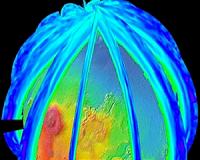 |
Pasadena CA (SPX) Sep 23, 2010 Methane in the atmosphere of Mars lasts less than a year, according to a study by Italian scientists. Sergio Fonti (Universita del Salento) and Giuseppe Marzo (NASA Ames) have used observations from NASA's Mars Global Surveyor spacecraft to track the evolution of the gas over three martian years. They presented their results at the European Planetary Science Congress in Rome on Tuesday 21st September. "Only small amounts of methane are present in the martian atmosphere, coming from very localized sources. We've looked at changes in concentrations of the gas and found that there are seasonal and also annual variations. The source of the methane could be geological activity or it could be biological - we can't tell at this point. However, it appears that the upper limit for methane lifetime is less than a year in the martian atmosphere," said Fonti. Levels of methane are highest in autumn in the northern hemisphere, with localized peaks of 70 parts per billion, although methane can be detected across most of the planet at this time of year. There is a sharp decrease in winter, with only a faint band between 40 and 50 degrees north. Concentrations start to build again in spring and rise more rapidly in summer, spreading across the planet. "One of the interesting things that we've found is that in summer, although the general distribution pattern is much the same as in autumn, there are actually higher levels of methane in the southern hemisphere. This could be because of the natural circulation occurring in the atmosphere, but has to be confirmed by appropriate computer simulations," said Fonti. There are three regions in the northern hemisphere where methane concentrations are systematically higher: Tharsis and Elysium, the two main volcano provinces, and Arabia Terrae, which has high levels of underground water ice. Levels are highest over Tharsis, where geological processes, including magmatism, hydrothermal and geothermal activity could be ongoing. "It's evident that the highest concentrations are associated with the warmest seasons and locations where there are favorable geological - and hence biological - conditions such as geothermal activity and strong hydration. The higher energy available in summer could trigger the release of gases from geological processes or outbreaks of biological activity," said Fonti. The mechanisms for removing methane from the atmosphere are also not clear. Photochemical processes would not break down the gas quickly enough to match observations. However, wind driven processes can add strong oxidizers to the atmosphere, such as the highly reactive salt perchlorate, which could soak up methane much more rapidly. Martian years are nearly twice as long as Earth years. The team used observations from the Thermal Emission Spectrometer (TES) on Mars Global Surveyor between July 1999 and October 2004, which corresponds to three martian years. The team studied one of the characteristic spectral features of methane in nearly 3 million TES observations, averaging data together to eliminate noise. "Our study is the first time that data from an orbiting spectrometer has been used to monitor methane over an extended period. The huge TES dataset has allowed us to follow the methane cycle in the martian atmosphere with unprecedented accuracy and completeness. Our observations will be very useful in constraining the origins and significance of martian methane," said Fonti. Methane was first detected in the martian atmosphere by ground based telescopes in 2003 and confirmed a year later by ESA's Mars Express spacecraft. Last year, observations using ground based telescopes showed the first evidence of a seasonal cycle. The atmosphere on Mars consists of 95% carbon dioxide, 3% nitrogen, 1.6% argon, and contains traces of oxygen and water, as well as methane.
Share This Article With Planet Earth
Related Links Mars Science Laboratory mission Mars News and Information at MarsDaily.com Lunar Dreams and more
 Tracing The Big Picture Of Mars' Atmosphere
Tracing The Big Picture Of Mars' AtmospherePasadena CA (JPL) Aug 30, 2010 One of the instruments on a 2016 mission to orbit Mars will provide daily maps of global, pole-to-pole, vertical distributions of the temperature, dust, water vapor and ice clouds in the Martian atmosphere. The joint European-American mission, ExoMars Trace Gas Orbiter, will seek faint gaseous clues about possible life on Mars. This instrument, called the ExoMars Climate Sounder, will supp ... read more |
|
| The content herein, unless otherwise known to be public domain, are Copyright 1995-2010 - SpaceDaily. AFP and UPI Wire Stories are copyright Agence France-Presse and United Press International. ESA Portal Reports are copyright European Space Agency. All NASA sourced material is public domain. Additional copyrights may apply in whole or part to other bona fide parties. Advertising does not imply endorsement,agreement or approval of any opinions, statements or information provided by SpaceDaily on any Web page published or hosted by SpaceDaily. Privacy Statement |